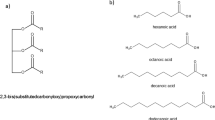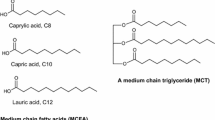Abstract
Rats (8 wk of age) fed a conventional diet were shifted to diets containing 10% Oenothera biennis Linn oil (OBLO, linoleic acid +γ-linolenic acid) from a wild plant, evening primrose oil (EPO, linoleic acid +γ-linolenic acid) from a cultivated plant, bio-γ-linolenic acid oil from mold (BIO, palmitic acid+oleic acid+linoleic acid+γ-linolenic acid), safflower oil (linoleic acid), palm oil (PLO, palmitic acid+oleic acid+linoleic acid), or soybean oil (linoleic acid+α-linolenic acid) with 0.5% cholesterol for 13 wk. Though there were no significant differences in the food intake among the groups, the body weight gain of the OBLO group was significantly lower than that of other groups except for the BIO and PLO groups, and that of the EPO and SPO groups were the highest among the groups. The liver weight of the OBLO group was significantly lower than that of other groups, and that of the PLO group was the highest among the groups. The serum total cholesterol and very low density lipoprotein (VLDL)+intermediate density lipoprotein (IDL)+low density lipoprotein (LDL) cholesterol concentrations of the OBLO and EPO groups were consistently lower than those in the other groups. However, those of the BIO group were higher than those in the OBLO and EPO groups. The liver cholesterol concentration of the PLO group was the highest among all groups except for the EPO group. The fecal neutral sterol and bile acid extraction of the BIO group tended to increase compared to other groups. The results of this study demonstrate that OBLO and EPO inhibit the increasing of serum total cholesterol and VLDL+IDL+LDL-cholesterol concentrations in the presence of excess cholesterol in the diet compared with the other dietary oils.
Similar content being viewed by others
Abbreviations
- AA 20∶4n-6:
-
arachidonic acid
- ALA 18∶3n-3:
-
α-linolenic acid
- BIO:
-
bio-γ-linolenic acid from mold
- DG:
-
diacylglycerol
- DHA 22∶6n-3:
-
docosahexaenoic acid
- EPA 20∶5n-3:
-
eicosapentaenoic acid
- EPO:
-
evening primrose oil
- GLC:
-
gas-liquid chromatography
- HDL:
-
high density lipoprotein
- IDL:
-
intermediate density lipoprotein
- LA 18⩺2n-6:
-
linoleic acid
- LDL:
-
low density lipoprotein
- OBLO:
-
Oenothera biennis Linn oil
- PC:
-
phosphatidylcholine
- PLO:
-
palm oil
- P/S:
-
polyunsaturated fatty acid/saturated fatty acid
- SBO:
-
soybean oil
- SFO:
-
safflower oil
- TG:
-
triacylglycerol
- VLDL:
-
very low density lipoprotein
References
Keys, A., Anderson, J.T., and Grande, F. (1957) Prediction of Serum Cholesterol Response of Man to Change in Fats in the Diet, Lancet 2, 959–966.
Hegsted, D.M., McGancy, R.B., Myers, M.L., and Stare, F.M. (1965) Quantitative Effects of Dietary Fat on Serum Cholesterol in Man, Am. J. Clin. Nutr. 17, 281–295.
Vega, G.L. Groszek, E., Wolf, R., and Grundy, S.M. (1982) Influence of Polyunsaturated Fats on Composition of Plasma Lipoproteins and Apolipoproteins, J. Lipod Res. 23, 811–822.
Ishihara, A., Ito, A., Sakai, K., Watanabe, S., Kobayashi, T., and Okuyama, H. (1995) Dietary High-Linoleate Safflower Oil Is Not Hypocholesterolemic in Aged Mice After a Long-Term Feeding-Comparison with Lard, Perilla Oil and Fish Oil, Biol. Pharm. Bull. 18, 485–490.
Choi, Y.S., Goto, S., Ikeda, I., and Sugano, M. (1989) Effect of Dietary n-3 Polyunsaturated Fatty Acids on Cholesterol Synthesis and Degradation in Rats of Different Ages, Lipids 24, 45–50.
AL-Shurbaji, A., Larsson-Backström, C., Berglund, L., Eggertsen, G., and Björkhem, I. (1991) Effect of n-3 Fatty Acids on the Key Enzymes Involved in Cholesterol and Triglyceride Turnover in Rat Liver, Lipids 26, 385–389.
Wong, S.H., Nestel, P.J., Trimble, R.P., Storer, G.B., Illman, R.J., and Topping, D.L. (1984) The Adaptive Effects of Dietary Fish and Safflower Oil on Lipid and Lipoprotein Metabolism in Perfused Rat Liver, Biochim. Biophys. Acta 792, 103–109.
Fukushima, M., Akiba, S., and Nakano, M. (1996) Comparative Hypocholesterolemic Effects of Six Vegetable Oils in Cholesterol-Fed Rat, Lipids 31, 415–419.
American Institute of Nutrition (1977) Report of the American Institute of Nutrition Ad Hoc Committee on Standards for Nutritional Studies, J. Nutr. 107, 1340–1348.
National Research Council (1985) Guide for the Care and Use of Laboratory Animals, Publication No. 85-23 (rev.). National Institutes of Health, Bethesda, MD.
Folch, J., Lees, M., and Sloane-Stanley, J.H. (1957) A Simple Method for the Isolation and Purification of Total Lipids from Animal Tissues, J. Biol. Chem. 226, 497–509.
Nakano, M., and Fischer, W. (1977) The Glycolipid of Lactobacillus casei DSM 20021, Hoppe-Seyler's Z. Physiol. Chem. 358, 1439–1453.
Matsubara, Y., Sawabe, A., and Iizuka, Y. (1990) Structures of New Linoroid Glycosides in Lemon, Agric. Biol. Chem. 54, 1143–1148.
Grundy, S.M., Ahrens, E.H., Jr., and Miettinen, T.A. (1965) Quantitative Isolation and Gas-Liquid Chromatographic Analysis of Total Fecal Bile Acids, J. Lipid Res. 6, 397–410.
Takada, R., Saitoh, M., and Mori, T. (1994) Dietary γ-Linolenic Acid-Enriched Oil Reduces Body Fat Content and Induces Liver Enzyme Activities Relating to Fatty Acid β-Oxidation in Rats, J. Nutr. 124, 469–474.
Huang, Y.-S., Manku, M.S., and Horrobin, D.F. (1984) The Effects of Dietary Cholesterol on Blood and Liver Polyunsaturated Fatty Acids and on Plasma Cholesterol in Rats Fed Various Types of Fatty Acids Diet, Lipids 19, 664–672.
Takahashi, R., Morse, N., and Horrobin, D.F. (1988) Plasma, Platelet, and Aorta Fatty Acids Composition in Response to Dietary n-6 and n-3 Fats Supplementation in a Rat Model of Non-Insulin-Dependent Diabetes, J. Nutr. Sci. Vitaminol. 34, 413–421.
Sugano, M., Ide, T., Ishida, T., and Yoshida, K. (1986) Hypocholesterolemic Effect of Gamma-Linolenic Acid as Evening Primrose Oil in Rats, Ann. Nutr. Metabol. 30, 289–299.
Horrobin, D.F., and Manku, M.S (1983) How Do Polyunsaturated Fatty Acids Lower Plasma Cholesterol Level?, Lipids 18, 558–562.
Lee, J.H., Sugano, M., and Ide, T. (1988) Effects of Various Combinations of ω3 and ω6 Polyunsaturated Fats with Saturated Fat on Serum Lipid Levels and Eicosanoid Production in Rats, J. Nutr. Sci. Vitaminol. 34, 117–129.
Grundy, S.M., and Denke, M.A. (1990) Dietary Influences on Serum Lipids and Lipoproteins, J. Lipid Res. 31, 1149–1172.
Author information
Authors and Affiliations
About this article
Cite this article
Fukushima, M., Matsuda, T., Yamagishi, K. et al. Comparative hypocholesterolemic effects of six dietary oils in cholesterol-fed rats after long-term feeding. Lipids 32, 1069–1074 (1997). https://doi.org/10.1007/s11745-997-0138-5
Received:
Revised:
Accepted:
Issue Date:
DOI: https://doi.org/10.1007/s11745-997-0138-5




